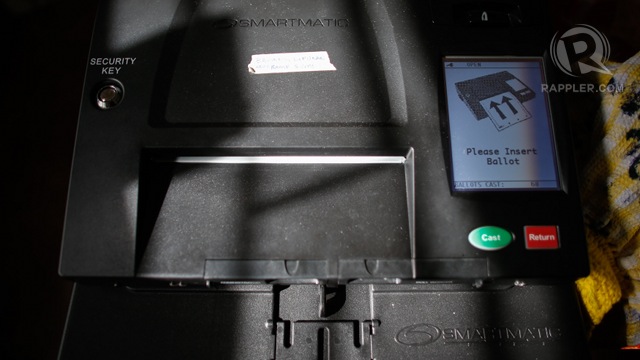SUMMARY
This is AI generated summarization, which may have errors. For context, always refer to the full article.

MANILA, Philippines – Ending a 3-year wait that has sustained doubts over the credibility of the automated polls, the Commission on Elections (Comelec) may soon open to local watchdogs the code that run ballot-counting machines.
But there’s a catch — it’s the source code for precinct count optical scan (PCOS) machines used in the 2010 presidential elections. The source code for 2013 is still held hostage in a legal battle.
Comelec chair Sixto Brillantes Jr said this will, at least, settle doubts over the credibility of the 2010 elections.
It may well affect the 2013 elections — critics, after all, have used the 2010 elections to question the credibility of this year’s polls. A group led by former Vice President Teofisto Guingona Jr said on Thursday, May 2, that they will complain against the Comelec before the United Nations.
“Maraming nagsasabi na wala raw 2010 source code. Gusto naming ilabas, para masabing meron,” Brillantes told reporters. (Many people say we don’t have the 2010 source code. We want to show it, so we can prove it’s there.)
The chairman said he is finalizing talks with the Bangko Sentral ng Pilipinas (BSP) over this. The law requires that the source code be kept in the BSP.
Watchdogs have blasted Comelec for failing to open the PCOS source code – for 2010 and for 2013 – to a review by local groups.
Brillantes, however, has said the local source code review is important “for credibility purposes, not for the legality or legitimacy of the elections.” He said what is important is the source code review by an independent, international group – which has taken place. (Read: FAQs: Why worry about PCOS code?)
Perceptions of fraud
Republic Act (RA) No. 9369, which amends the Automated Election System (AES) Law, defines the source code as “human-readable instructions that define what the computer equipment will do.”
For watchdogs, a source code review can dispel perceptions of fraudulent elections. The source code, they say, can be manipulated to not read actual votes on the ballot, but totals pre-programmed into the system.
In 2010, it was a clear survey frontrunner – Benigno Aquino III – who won the presidency. There have been questions however why his vote share, whether from bailiwicks or not, were practically uniform with his vote share in the last pre-election survey.
The vice presidency remains contested to this day, after President Aquino’s running mate, Manuel “Mar” Roxas II, protested the victory of Vice President Jejomar Binay. Publicized surveys two weeks before the elections showed Roxas ahead, but internal surveys as recent as 3 days before the elections showed Binay overtaking Roxas.
That year, the Supreme Court already ordered the Comelec to release the source codes for the automated elections for a review by local groups.
The 7-page SC decision said this is clearly stated by the Automated Election System Law: “Once an AES technology is selected for implementation, the Commission shall promptly make the source code of that technology available and open to any interested political party or groups which may conduct their own review thereof.”
Impact on 2013
Now, how will the 2010 source code improve the credibility of the 2013 elections? Brillantes replied: “It will not.”
“It will only debunk what was stated by those people who are saying wala raw source code noong 2010, drama lang daw ‘yung nagpunta sa Central Bank, na wala naman talagang nilagay na source code doon. Gusto ko lang i-prove na meron talagang naninira,” he explained.
(It will only debunk what was stated by those people who are saying there was no source code in 2010, that our going to the Central Bank was plain drama, that we didn’t really deposit a source code there. I just want to prove there are people who want to destroy our credibility.)
Brillantes, however, didn’t close the possibility that the public will see the source code for 2013. He said he will soon update the public on this.
The US-based Dominion Voting Systems had prohibited the release of the PCOS source code for a review by Philippine groups. Dominion did this because of a legal battle with the Venezuelan firm Smartmatic, which sold the Philippines its PCOS machines.
For 2013, the PCOS machine has undergone a series of tests – the last of which is the final testing and sealing process. This began on Thursday. (Watch Rappler’s video report below.)
Over 78,000 PCOS machines have undergone tests such as the source code review done by the Denver-based SLI Global Solutions, and the mock elections last February 2. – Rappler.com
Add a comment
How does this make you feel?
There are no comments yet. Add your comment to start the conversation.